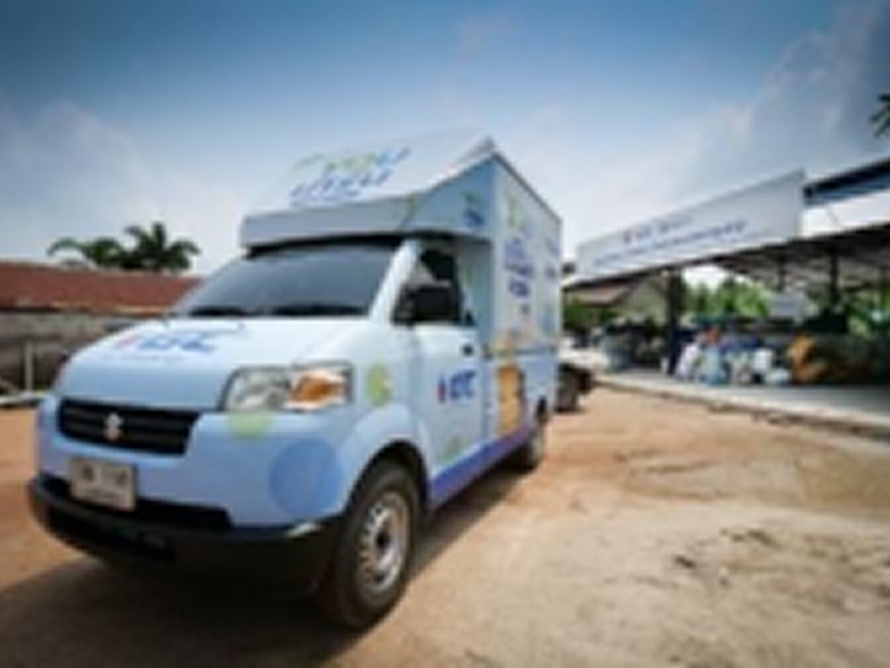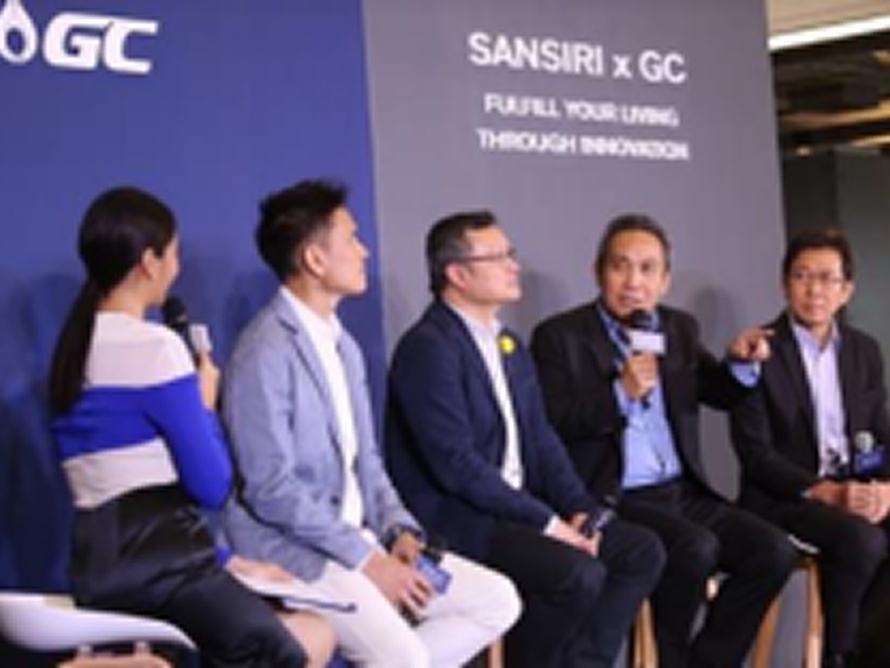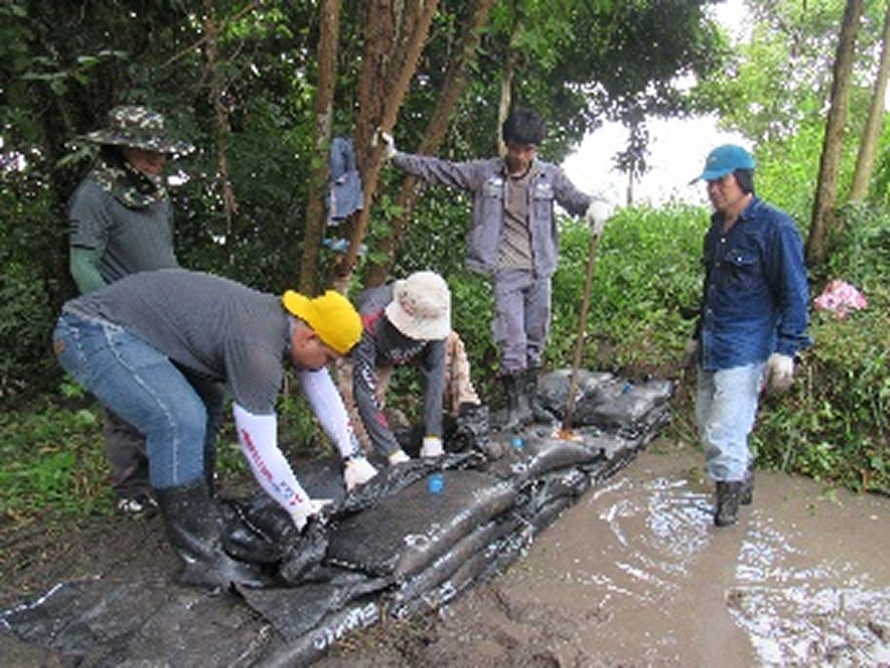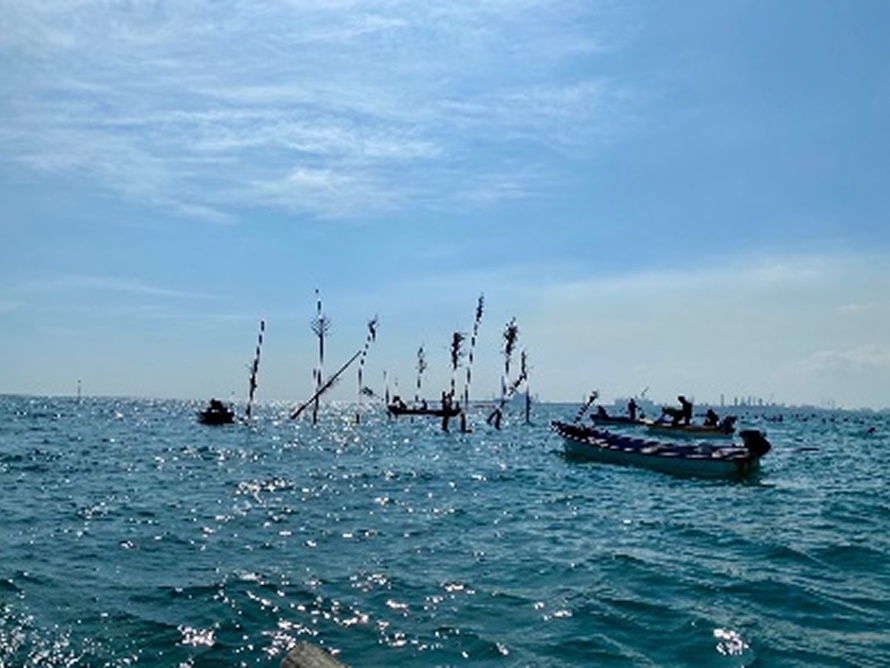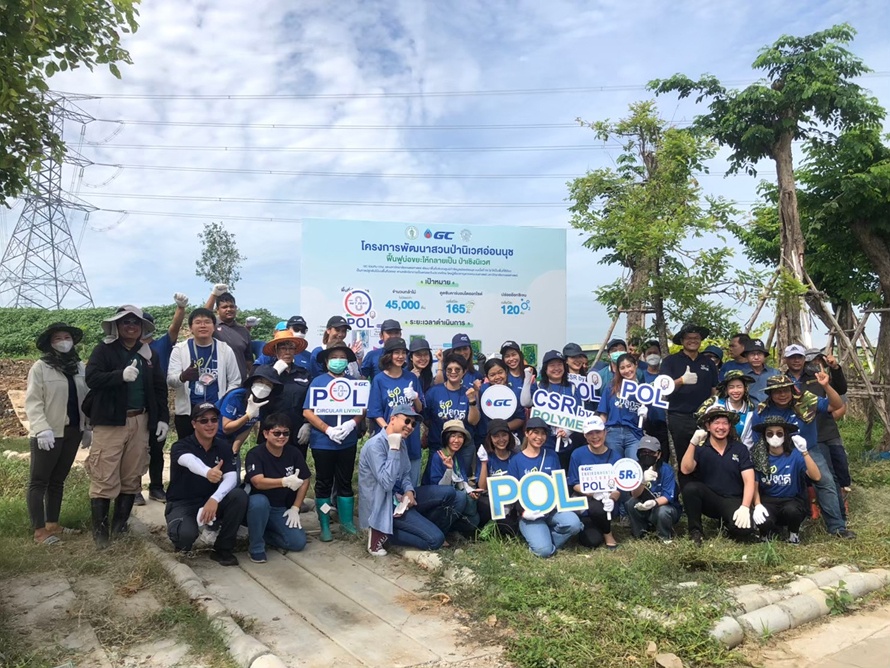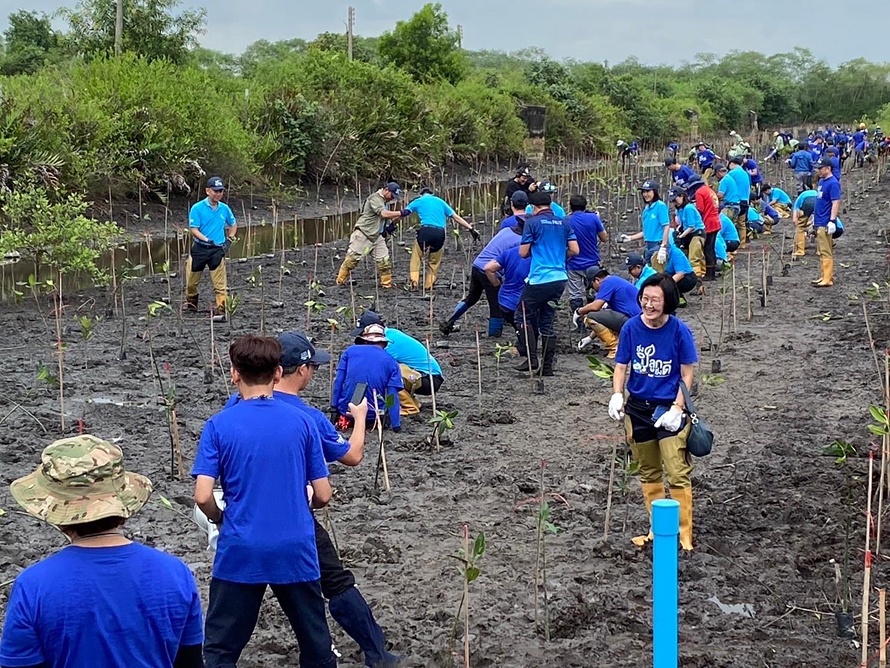Biodiversity
Management Approach GRI 3-3 (2021)
The degradation of biodiversity, the deterioration of natural habitats, and the impacts of climate change significantly affect the economy, human health, and the livelihoods of all living beings. GC recognizes the urgency of these risks and is committed to supporting the Kunming-Montreal Global Biodiversity Framework (GBF) to help halt and reverse nature loss by 2030.
To achieve this goal, GC has adopted the approach of the Taskforce on Nature-related Financial Disclosures (TNFD) to assess biodiversity-related risks by analyzing both impacts and dependencies on nature. Implementing this international standard enables GC to effectively identify and assess risks, preparing for disclosure in line with TNFD recommendations, and supporting operations that contribute to the long-term sustainability of ecosystems and the economy.
Mitigation Hierarchy Principle
- Avoid – GC is committed to not operating business activities in critical biodiversity areas and minimizing environmental impacts through its QSHEB policy. This includes Environmental Impact Assessments (EIA), integration of biodiversity considerations, environmental risk management, development of environmentally friendly innovations, and extending risk reduction measures across the supply chain. These efforts aim to achieve No Net Loss (NNL) of biodiversity, Net Positive Impact (NPI), and No Gross Deforestation.
- Minimize – GC operates an environmental management system verified by third parties, with a focus on key biodiversity areas. It collaborates with government bodies and industrial estates and monitors performance through KPIs such as water use, greenhouse gas emissions, and pollution levels. Nature-related risks are also integrated into the Enterprise Risk Management (ERM) process. Additionally, GC develops initiatives such as eco-design and biodegradable plastics.
- Restore – GC focuses on ecosystem restoration and conservation through water management programs, including reforestation for both terrestrial and marine ecosystem rehabilitation. One example is the Rayong Coastal Marine Resource Conservation Project, part of a 10-year long-term restoration plan. The Company also assesses water-related risks, including water resource management and flood risks, to mitigate climate change and pollution impacts on biodiversity.
- Offset – GC expands reforestation and ecosystem restoration projects in areas affected by biodiversity loss, implementing Nature-based Solutions (NbS). This includes reforesting 8,600 acres in partnership with government agencies, private sector stakeholders, and local communities. The Company also collaborates with partners on research and development of Carbon Capture and Storage (CCS), Carbon Capture, Utilization and Storage (CCUS), and invests through its Corporate Venture Capital (CVC) fund.
To ensure the biodiversity management and value integration, GC has commitment, compliance, and monitoring in own operation and suppliers. Any environmental impacts are into the consideration and the business decision process. The mitigations of biodiversity loss and deforestation are integrated and communicated within business activities, and with external organizations.
As abovementioned, GC demonstrates the commitment to achieve a No Net Loss (NNL) of biodiversity values within manageable boundaries as well as the commitment to appropriately maintain current and future operational sites to create Net Positive Impact (NPI), where applicable. GC also commits to ‘No Net Deforestation’ throughout value chain, including Tier-1 suppliers and business partners, and ‘No Gross Deforestation’ for our own operation’s activities, that also align with the Net Zero Goal (Compensation-Driven) in 2050. GC has defined the commitment and biodiversity targets to be aligned with the Net Zero Goal (Compensation-Driven). In this regard, GC targets to offset around 1 million tons of carbon using nature-based solutions by 2050.
GC has established regulations to manage relevant key issues in the Quality, Security, Safety, Occupational Health, Environment, and Business Continuity (QSHEB) Policy, the GC Biodiversity Statement, and the No Deforestation Commitment, which are issued by GC’s Board of Directors.
Engagement and Collaboration with the Biodiversity Network
GC collaborates with local communities, government agencies, academic institutions, and private organizations through the Step-Up CSR strategy, which comprises three core strategies: Better Living, Better Sharing, and Better Ecology. These strategies are aligned with GC’s Net Zero greenhouse gas emissions target and commitment to the Circular Economy. The Company also expands its Social Enterprise initiatives through various projects.
GC is dedicated to tackling climate change, conserving nature, and delivering benefits to local communities by promoting social enterprises that generate income and support long-term economic growth. Environmental and social outcomes are achieved through key initiatives such as the Khao Huai Mahat Forest and Water Conservation Project, which restores forest areas to increase biodiversity and carbon sequestration capacity; The More You Plant, the Better project, which encourages natural carbon absorption across several Thai provinces; and the Rayong Wanarom Ecological Forest project, which focuses on increasing green space and biodiversity in Rayong. Additionally, the Company supports the conservation of marine resources along the Rayong coastline through fish aggregating devices and mangrove restoration. It also partners with OR via the YOUturn platform to drive integrated waste management and environmentally friendly product development, with the goal of becoming the ASEAN leader in recycled plastics by 2030. In collaboration with Sansiri, GC also develops sustainable products, such as high-quality plastic water tanks and low-VOC paints, to support sustainable lifestyles.
Moreover, GC works with communities around industrial estates across Asia to implement biodiversity-enhancing forestation projects under a compensation-driven approach, contributing to emission reduction goals and fostering long-term environmental and economic sustainability.
Collaboration with the Biodiversity Network
| External Partner / Institutions | Collaboration in Biodiversity |
|---|---|
| Department of Marine and Coastal Resources | Supported and cooperated the activities in the coastal areas, and the participation in the activities with local communities. |
|
Kasetsart University Air and Coastal Defense Command (ACDC) Konrakpa Club under the Charklukya – Huai Mahat community |
The long-term development initiative with a 10-year timeframe from 2013-2023. The objective is to rehabilitate Khao Huai Mahat’s 2,500 rai ecosystem |
| Ban Chang local community | Cooperation in the implementation of the Rayong Wanarom Ecological Forest Project under the supervision of GC Group |
|
Department of Environment, Bangkok Metropolitan Administration (BMA) Kasetsart University |
Collaborated to develop the former landfill area at the On Nut Waste Disposal Center, covering 55 rai, into a green space under the tree-planting project 'The More You Plant, The Better'. |
| Department of Marine and Coastal Resources (DMCR) | The collaboration on the mangrove reforestation project for carbon credit benefits promotes cooperation among all sectors including government, private sector, and local communities to conserve, restore, and expand mangrove areas, enhancing their richness. This initiative is one of the approaches to reduce greenhouse gas emissions |
| Office of Natural Resources and Environmental Policy (ONEP) in collaboration with the United Nations Development Program (UNDP) | Participating in a small group meeting under the Global Biodiversity Framework Early Action Support Program, working together to provide recommendations on national goals and the National Biodiversity Strategy and Action Plan (NBSAP) Volume 5 as well as drive OECMs in preparation for urgent implementation, leading to action under the Kunming-Montreal Global Biodiversity Framework. This initiative is a collaboration between the Office of Natural Resources and Environmental Policy (ONEP), the United Nations Development Program (UNDP), GBF-EAS consultants, and the International Union for Conservation of Nature (IUCN). |
| PTT Oil and Retail Business Public Company Limited (OR) | Utilizing the YOUturn waste management platform and OR’s retail platform to drive the production of environmentally friendly products and bioplastics. |
| Sansiri Public Company Limited | Developing high-quality products that support sustainable lifestyles, are durable, energy-efficient, and environmentally friendly, made from natural ingredients and free from harmful volatile organic compounds (VOCs). |
Biodiversity Highlight Programs
Over the past several years, GC has conserved and promoted biodiversity through numerous environmentally beneficial projects, all implemented in accordance with the Mitigation Hierarchy Principle.
Minimize
The collaborative project leverages the comprehensive waste management platform YOUturn alongside the retail platform of PTT Oil and Retail Business Public Company Limited (OR).
GC collaborates with PTT Oil and Retail Business Public Company Limited (OR) to utilize the YOUturn waste management platform and OR’s retail platform to drive the production of environmentally friendly products and bioplastics. The goal is to become the largest recycled plastics producer in ASEAN and rank among the global leaders.
The collaborative project to develop high-quality products with Sansiri Public Company Limited.
GC collaborates with Sansiri Public Company Limited to develop products that support sustainable lifestyles, such as durable and energy-efficient resin plastic water tanks and environmentally friendly paints made from natural ingredients and free from harmful volatile organic compounds (VOCs). These products enable consumers to choose options that are healthier for both their well-being and the environment in their daily lives.
Restore
Huai Mahat Forest Restoration Project
GC collaborated with Kasetsart University, the Air and Coastal Defence Command, and the Chak Luk Ya–Huai Mahat Forest Conservation Club to rehabilitate 2,500 rai of land on Huai Mahat Mountain in Rayong Province. The project aims to restore upstream forests, enhance ecosystem richness, improve the quality of life and economy of local communities, and promote forest resource and biodiversity conservation.
Currently, the reforested area is capable of sequestering 32,807 tonnes of CO₂ equivalent and has been certified under the Low Emission Support Scheme (LESS) by the Thailand Greenhouse Gas Management Organization. Over the 10-year project period, biodiversity studies have identified a total of 146 plant species and 463 animal and insect species. The initiative has also generated over THB 5.6 million in income for the local community through employment and the support of local products and services.
Huai Mahat Forest Restoration ProjectMarine Resource Conservation along the Rayong Coastline Project
The Marine Resource Conservation Project along the Rayong coastline aims to restore ecological richness and balance, ensuring the long-term sustainability of the local marine environment. For the people of Rayong, small-scale coastal fishing is a traditional livelihood closely tied to the province’s abundant coastal resources. In response, GC has designed project activities to address multiple dimensions, supporting both terrestrial and marine biodiversity.
-
Building marine habitats using fish traps
Building coastal habitats for marine animals can help improve aquatic biodiversity along the coastline of Rayong province through the use of fish traps which provide a barrier allowing a fishery conservation area. This supports the United Nations Sustainable Development Goal 14: Life Below Water.
Project Operations and Performance:
Built 29 groups, 350 fish traps
-
Releasing marine species
GC, in collaborating with PTT Group, released marine species in suitable sea conditions including sea bass, spotted babylon, soft cuttlefish, black tiger prawn, and banana shrimp.
Project Operations and Performance:
Released 16 groups of aquatic animals, including fish, shrimps, crabs, and shellfish, totaling to more than 50 million animals.
-
Aquatic Animal Bank (Mud Crabs, Berried Blue Swimming Crab, Fish, and Squid)
The project involves collecting aquatic animal eggs for hatching and rearing before releasing the juveniles back into the sea, helping to increase the natural population. In addition, local fishers voluntarily limit their catch during critical periods by avoiding fishing during spawning seasons or refraining from catching broodstock for sale or consumption. This practice has led to a rise in marine animal populations and increased income for fishers.
Project operation and performance:
The Aquatic Animal Bank initiative was carried out in collaboration with 24 fishing groups, comprising 6 mud crab banks, 16 berried blue swimming crab banks, and 2 fish and squid banks.
Offset
On Nut Ecological Forest Park Development Project
GC, in collaboration with the Bangkok Metropolitan Administration and Kasetsart University, developed and rehabilitated a former 55-rai landfill area at the On Nut Waste Disposal Center in Bangkok into a green space in the form of an “ecological forest.” Tree planting was carried out on the former landfill based on academic principles by experts from the Faculty of Forestry, Kasetsart University.
This reforestation project not only helps mitigate pollution impacts but also enhances biodiversity and improves environmental quality. Over the past two years, more than 45,000 trees have been planted. Surveys have identified 79 plant species and 158 animal and insect species. The ecological forest has the potential to sequester 165 tons of carbon dioxide equivalent per year and release 120 tons of oxygen annually.
The project aligns with GC’s biodiversity sustainability policy and its Net Zero target by 2050, while also supporting the Bangkok Metropolitan Administration’s urban forest expansion initiative.
Mangrove Reforestation Project for Carbon Credit Benefits
GC collaborated with the Department of Marine and Coastal Resources to implement a mangrove reforestation project for carbon credit benefits. This initiative promotes cooperation among all sectors including government, private sector, and local communities to conserve, restore, and expand mangrove areas, enhancing their richness. This effort is one of the strategies to reduce greenhouse gas emissions and address the current global warming crisis.
GC has carried out mangrove planting in four provinces: Rayong, Trat, Chanthaburi, and Phetchaburi, covering a total area of more than 2,900 rai. It is estimated that the project will sequester approximately 4,000 tonnes of CO2 equivalent per year. Additionally, it supports biodiversity in the mangrove ecosystem which serves as a habitat for aquatic animals and native plants that play a vital role in maintaining ecological balance.
Baseline biodiversity studies have identified 102 plant species, 113 animal species, and 36 insect species. This project is another approach supporting carbon offsetting through nature-based solutions, aligning with GC’s commitment to reduce greenhouse gas emissions by 20 percent by 2030 and to achieve stable Net Zero carbon status by 2050.
